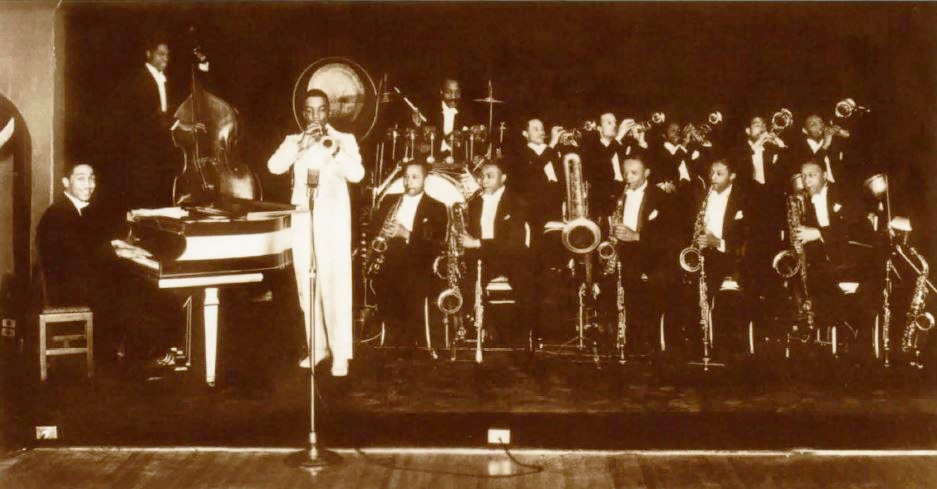From the mid-1920s until the mid-1950s, this two-block area, made famous in Erskine Hawkins's song, "Tuxedo Junction," served as the hub of nightlife for the surrounding predominately black communities of Ensley, Fairfield, Wylam, Bush Hills, and Pratt City. The Junction was the only venue for dining, dancing, shopping and live music that Birmingham's black population could call its own. But what a place it was. The renowned intersection was the turn-around point for the Birmingham Trolley Company's Wylam and Pratt City streetcars. Locals simply called it the Junction. Many of the residents, partygoers, and fun-seekers who were employed at the steel mill, iron works, or lumber mill, would catch the trolley after a shower and fresh change of clothes at work and head straight to the Junction for an evening of food, fun, and entertainment.
Work clothes or casual apparel were permissible for a bar and lounge, but totally unacceptable attire for the ballroom. And the ballroom was, after all, the evening's ultimate destination. A zoot suit and two-tone shoes or a tux was the appropriate evening attire for men. But few of the gentlemen clientele owned a tuxedo. And if they did, transporting it from work proved impractical. Quite naturally, one wanted to arrive freshly adorned. Many have said that an enterprising store owner in the vicinity, perhaps the proprietor of Johnson's Cleaners, olved the dilemma. He started renting tuxedos. This arrangement undoubtedly brought in a steady flow of business for the storeowner but surely necessitated some very long work hours as patrons went out to "dance the night away."
With the clothing issue settled, another concern remained: a man has got to eat if he's going to dance. The Junction offered several dining options. Burgers, pig ear sandwiches, fried chicken wings, neck bones and red beans, or chitterlings and collards were always on the menu at most of the local eateries along the strip. And there was usually a weekend fish fry or barbeque in someone's front yard a block or two over--often held as fundraisers to assist a neighbor in getting together the month's rent. The Junction was first and foremost a nurturing community.
From the mid-1920s until the mid-1950s, this two-block area, made famous in Erskine Hawkins's song, "Tuxedo Junction," served as the hub of nightlife for the surrounding predominately black communities.
Tuxedo Junction not only gave Hawkins inspiration for his hit song, but also served as a springboard for an array of other soon-to-be musical icons such as Lionel Hampton (another boyhood resident of the Junction); Urbie Green (a local performer who was to become the most-recorded studio musician in the music industry); Ella Fitzgerald; B.B. King; and Nat "King" Cole.
But the Junction was not without controversy. One long-time Ensley resident said, "There was nothing but juke joints and bars all up and down the street. My folks didn't allow us in Tuxedo Junction. But we sneaked down there from time to time, just to have a look at all the goings-on."
Tuxedo Junction not only gave Hawkins inspiration for his hit song, but also served as a springboard for an array of other soon-to-be musical icons.
The heady days of Tuxedo Junction are gone, the victim of urban growth. Bars and juke joints have given way to day-care centers and fa t-food joints. But the surrounding community remains cognizant and proud of its contributions to the fabric of American culture. Every summer during the last weekend of July, the Erskine Hawkins Foundation and the City of Birmingham sponsor a festival known as the "Function in the Junction." The event, which recently celebrated its nineteenth year, is held in the Erskine Hawkins Park, one block from the old Nixon ballroom. The park itself pays homage to the community's rich musical heritage. Its sidewalks are inlaid with large musical notes, and a collage of the Junction's musical history adorns the side of a barbershop that years ago was one of the Junction's favorite juke joints. But more than anything else, the Function commemorate the contributions and sacrifices of Birmingham's African-American musical pioneer who orchestrated harmony both in their music and in their society.
Just like in the old days at the Nixon ballroom, it's anyone's guess which renowned entertainers or up-and-coming talent may drop by to jam. In years past, crowds have been surprised by impromptu performances by Benny Latimore, members of the Delphonics, Manhattan Transfer, the S.O.S. Band, Denni Edwards, and some of the Temptations. As the sun goes down, and the crowd settles into lawn chairs and onto blankets, the mingled aromas of ladies' perfumes, sweaty summer nights, and a nearby fish fry again fill the air.
Author
Donald E. Rohar taught English at Birmingham's Ensley High School.
This article was previously published in Issue #76, Spring 2005.

 RSS Feed
RSS Feed